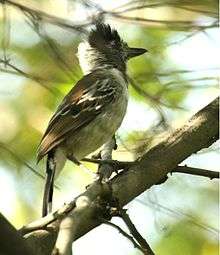Collared antshrike
The collared antshrike (Thamnophilus bernardi) is a species of bird in the family Thamnophilidae. It is found in Ecuador and Peru. Its natural habitats are subtropical or tropical dry forests, subtropical or tropical dry shrubland, and subtropical or tropical moist shrubland.
| Collared antshrike | |
|---|---|
 | |
| Scientific classification | |
| Kingdom: | Animalia |
| Phylum: | Chordata |
| Class: | Aves |
| Order: | Passeriformes |
| Family: | Thamnophilidae |
| Genus: | Thamnophilus |
| Species: | T. bernardi |
| Binomial name | |
| Thamnophilus bernardi Lesson, 1844 | |
| Synonyms | |
|
Sakesphorus bernardi | |
The collared antshrike was described by the French naturalist René Lesson in 1844 and given the binomial name Thamnophilus bernardi (the genus was misspelled as Tamnophilus) with the type locality of Guayaquil in Ecuador. The specific epithet honours Captain Bernard, a French mariner and collector from Bordeaux.[2] The collared antshrike was subsequently placed in the genus Sakesphorus. A molecular phylogenetic study published in 2007 found that Sakesphorus was polyphyletic and that three species including the collared antshrike were embedded within a clade containing members of Thamnophilus. The collared antshrike was therefore moved back to its original genus.[3][4]
References
- BirdLife International (2016). "Thamnophilus bernardi". IUCN Red List of Threatened Species. 2016. doi:10.2305/IUCN.UK.2016-3.RLTS.T103658059A93820395.en.
- Lesson, René (1844). "Ornithologie: Catalogue des oiseaux nouveaux ou peu connu de la collection Abeillé". L'Écho du monde savant et l'Hermès : journal analytique des nouvelles et des cours scientifiques (in French). 11 (2). Col. 348.
- Brumfield, R.T. (May 2007). "Proposal (278): Transfer some Sakesphorus species into Thamnophilus (Thamnophilidae)". South American Classification Committee of the American Ornithological Society. Retrieved 8 March 2018.
- Gill, Frank; Donsker, David, eds. (2018). "Antbirds". World Bird List Version 8.1. International Ornithologists' Union. Retrieved 23 February 2018.
